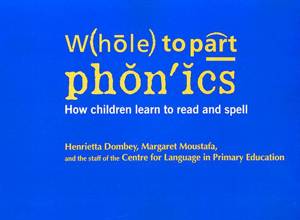
- Retrait gratuit dans votre magasin Club
- 7.000.000 titres dans notre catalogue
- Payer en toute sécurité
- Toujours un magasin près de chez vous
- Retrait gratuit dans votre magasin Club
- 7.000.0000 titres dans notre catalogue
- Payer en toute sécurité
- Toujours un magasin près de chez vous
Whole to Part Phonics
How Children Learn to Read and Spell
Margaret Moustafa, Myra Barrs, Sue Ellis, Henrietta Dombey, Helen Bromley, Clare KellyDescription
Significant recent research in literacy learning casts serious doubt on the effectiveness of traditional phonics instruction. Researchers have discovered that traditional phonics, with its emphasis on letters, sounds, and words, ignores the complexity of children's natural learning processes, including children's inclination to focus first on the text, then on whole words, and then on their constituent parts. Whole to Part Phonics offers a concise, accessible introduction to this research and proven strategies for translating it into effective classroom practice.
The contributors to Whole to Part Phonics recognize that children need to understand letter-sound relationships in order to become independent and fluent readers. But, they argue, this knowledge is of little value unless children learn how to use it in context. Accordingly, the authors maintain that children's encounters with print lay the groundwork for effective phonics learning. By drawing on children's wider experience of reading and on their preferred modes of learning, whole-to-part phonics offers an exciting alternative--students focus on the construction of meaning rather than the decoding of text.
In Part I, Henrietta Dombey explains how phonics works in English and surveys the research evidence for whole-to-part phonics. Margaret Moustafa then offers advice on using whole-to-part phonics strategies in a rich, literature-based reading program. Olivia O'Sullivan of the Centre for Language in Primary Education (CLPE) surveys research that investigates the connection between developmental spelling and reading. In Part II, the staff of the CLPE offers a set of detailed, practical suggestions for promoting the knowledge children need to learn letter-sound relationships and use them effectively in both their reading and writing.
Spécifications
Parties prenantes
- Auteur(s) :
- Editeur:
Contenu
- Nombre de pages :
- 48
- Langue:
- Anglais
Caractéristiques
- EAN:
- 9780325001203
- Date de parution :
- 06-11-98
- Format:
- Livre broché
- Format numérique:
- Trade paperback (VS)
- Dimensions :
- 285 mm x 205 mm
- Poids :
- 136 g

Les avis
Nous publions uniquement les avis qui respectent les conditions requises. Consultez nos conditions pour les avis.






